Strategic Communication within Organization Management Report
VerifiedAdded on 2022/10/18
|10
|2360
|26
Report
AI Summary
This report delves into the critical role of management communication within organizations. It emphasizes strategic communication as a cornerstone for success, covering corporate communication functions such as identity, image, reputation, corporate responsibility, media relations, and crisis management. The report highlights why a CEO should prioritize strategic communication, including transparency, teamwork, reduced miscommunication, brand protection, and improved customer service. It also outlines the steps for successful implementation, focusing on gathering information, prioritizing key concepts, and involving both internal and external parties. The conclusion underscores the significance of effective corporate communication in achieving an organization's mission and vision, with the CEO playing a central role in its planning and execution. The report references several academic sources to support its claims.
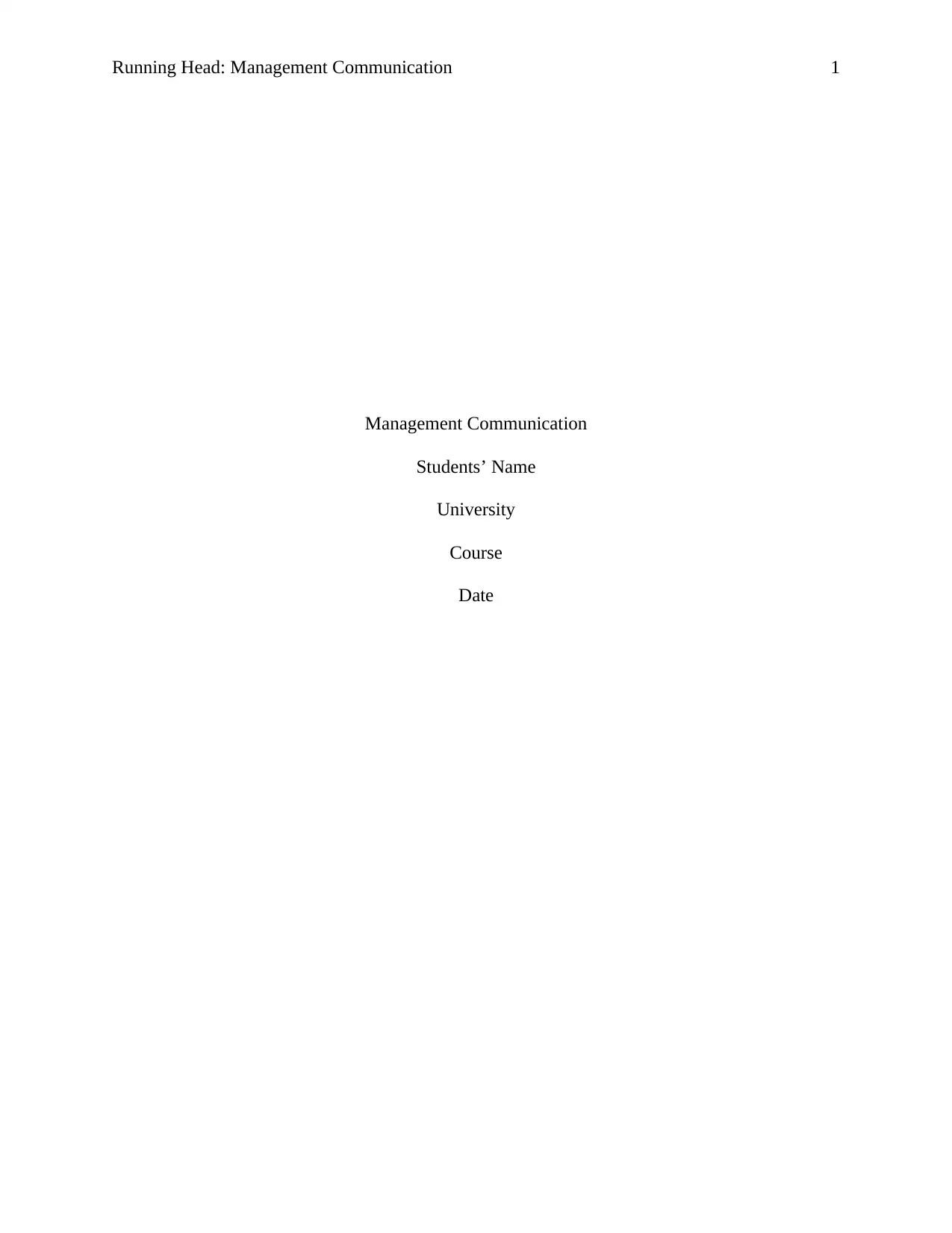
Running Head: Management Communication 1
Management Communication
Students’ Name
University
Course
Date
Management Communication
Students’ Name
University
Course
Date
Paraphrase This Document
Need a fresh take? Get an instant paraphrase of this document with our AI Paraphraser
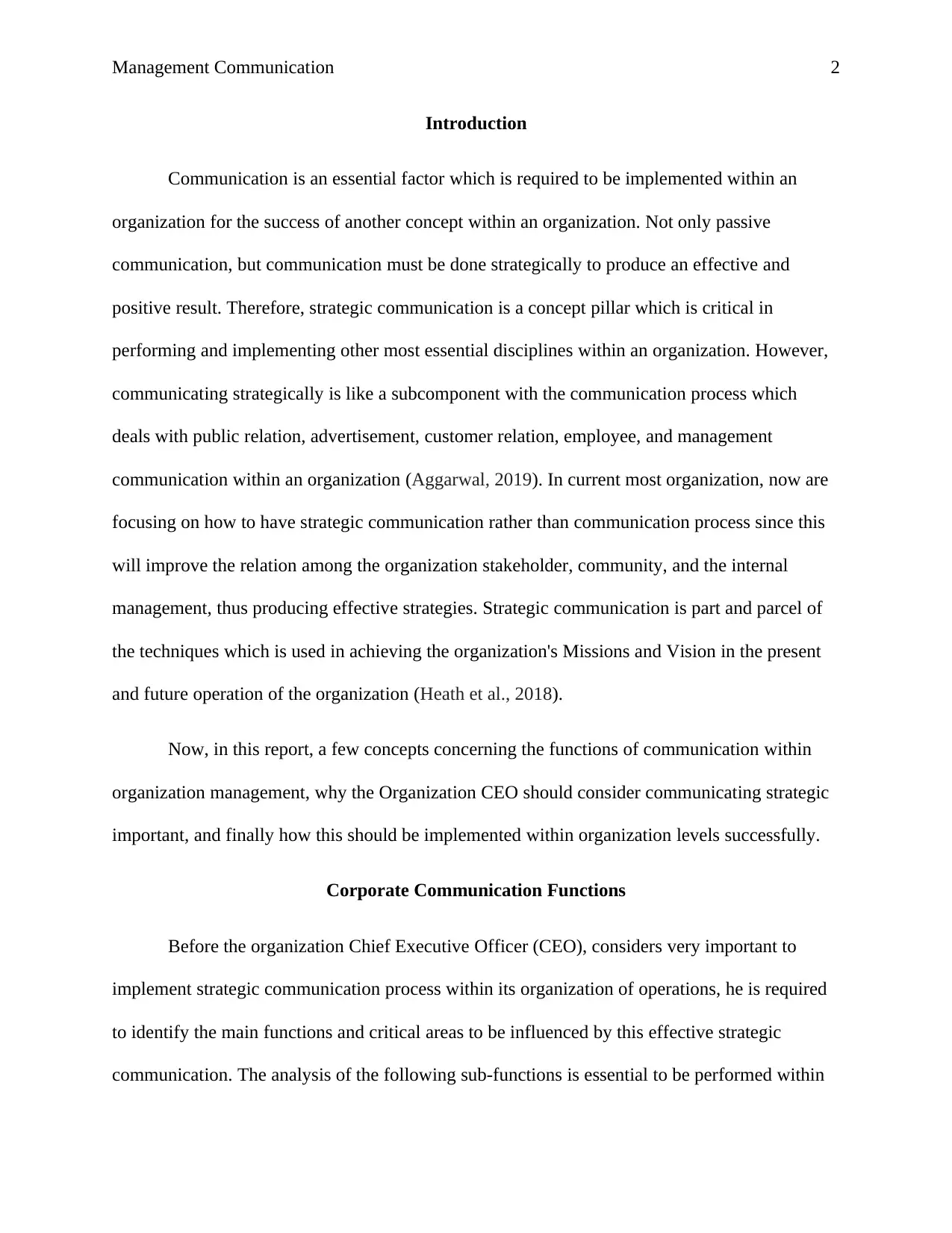
Management Communication 2
Introduction
Communication is an essential factor which is required to be implemented within an
organization for the success of another concept within an organization. Not only passive
communication, but communication must be done strategically to produce an effective and
positive result. Therefore, strategic communication is a concept pillar which is critical in
performing and implementing other most essential disciplines within an organization. However,
communicating strategically is like a subcomponent with the communication process which
deals with public relation, advertisement, customer relation, employee, and management
communication within an organization (Aggarwal, 2019). In current most organization, now are
focusing on how to have strategic communication rather than communication process since this
will improve the relation among the organization stakeholder, community, and the internal
management, thus producing effective strategies. Strategic communication is part and parcel of
the techniques which is used in achieving the organization's Missions and Vision in the present
and future operation of the organization (Heath et al., 2018).
Now, in this report, a few concepts concerning the functions of communication within
organization management, why the Organization CEO should consider communicating strategic
important, and finally how this should be implemented within organization levels successfully.
Corporate Communication Functions
Before the organization Chief Executive Officer (CEO), considers very important to
implement strategic communication process within its organization of operations, he is required
to identify the main functions and critical areas to be influenced by this effective strategic
communication. The analysis of the following sub-functions is essential to be performed within
Introduction
Communication is an essential factor which is required to be implemented within an
organization for the success of another concept within an organization. Not only passive
communication, but communication must be done strategically to produce an effective and
positive result. Therefore, strategic communication is a concept pillar which is critical in
performing and implementing other most essential disciplines within an organization. However,
communicating strategically is like a subcomponent with the communication process which
deals with public relation, advertisement, customer relation, employee, and management
communication within an organization (Aggarwal, 2019). In current most organization, now are
focusing on how to have strategic communication rather than communication process since this
will improve the relation among the organization stakeholder, community, and the internal
management, thus producing effective strategies. Strategic communication is part and parcel of
the techniques which is used in achieving the organization's Missions and Vision in the present
and future operation of the organization (Heath et al., 2018).
Now, in this report, a few concepts concerning the functions of communication within
organization management, why the Organization CEO should consider communicating strategic
important, and finally how this should be implemented within organization levels successfully.
Corporate Communication Functions
Before the organization Chief Executive Officer (CEO), considers very important to
implement strategic communication process within its organization of operations, he is required
to identify the main functions and critical areas to be influenced by this effective strategic
communication. The analysis of the following sub-functions is essential to be performed within
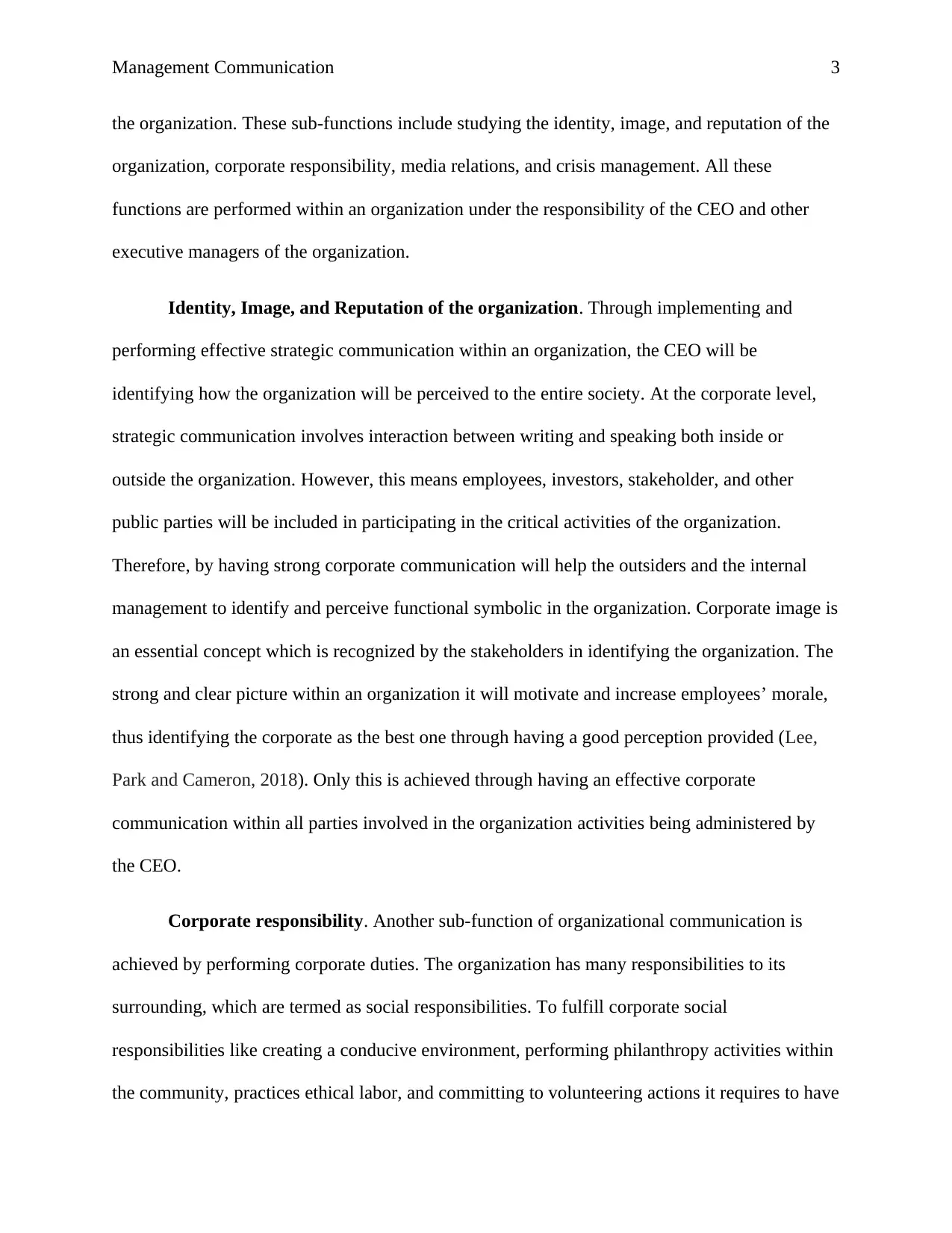
Management Communication 3
the organization. These sub-functions include studying the identity, image, and reputation of the
organization, corporate responsibility, media relations, and crisis management. All these
functions are performed within an organization under the responsibility of the CEO and other
executive managers of the organization.
Identity, Image, and Reputation of the organization. Through implementing and
performing effective strategic communication within an organization, the CEO will be
identifying how the organization will be perceived to the entire society. At the corporate level,
strategic communication involves interaction between writing and speaking both inside or
outside the organization. However, this means employees, investors, stakeholder, and other
public parties will be included in participating in the critical activities of the organization.
Therefore, by having strong corporate communication will help the outsiders and the internal
management to identify and perceive functional symbolic in the organization. Corporate image is
an essential concept which is recognized by the stakeholders in identifying the organization. The
strong and clear picture within an organization it will motivate and increase employees’ morale,
thus identifying the corporate as the best one through having a good perception provided (Lee,
Park and Cameron, 2018). Only this is achieved through having an effective corporate
communication within all parties involved in the organization activities being administered by
the CEO.
Corporate responsibility. Another sub-function of organizational communication is
achieved by performing corporate duties. The organization has many responsibilities to its
surrounding, which are termed as social responsibilities. To fulfill corporate social
responsibilities like creating a conducive environment, performing philanthropy activities within
the community, practices ethical labor, and committing to volunteering actions it requires to have
the organization. These sub-functions include studying the identity, image, and reputation of the
organization, corporate responsibility, media relations, and crisis management. All these
functions are performed within an organization under the responsibility of the CEO and other
executive managers of the organization.
Identity, Image, and Reputation of the organization. Through implementing and
performing effective strategic communication within an organization, the CEO will be
identifying how the organization will be perceived to the entire society. At the corporate level,
strategic communication involves interaction between writing and speaking both inside or
outside the organization. However, this means employees, investors, stakeholder, and other
public parties will be included in participating in the critical activities of the organization.
Therefore, by having strong corporate communication will help the outsiders and the internal
management to identify and perceive functional symbolic in the organization. Corporate image is
an essential concept which is recognized by the stakeholders in identifying the organization. The
strong and clear picture within an organization it will motivate and increase employees’ morale,
thus identifying the corporate as the best one through having a good perception provided (Lee,
Park and Cameron, 2018). Only this is achieved through having an effective corporate
communication within all parties involved in the organization activities being administered by
the CEO.
Corporate responsibility. Another sub-function of organizational communication is
achieved by performing corporate duties. The organization has many responsibilities to its
surrounding, which are termed as social responsibilities. To fulfill corporate social
responsibilities like creating a conducive environment, performing philanthropy activities within
the community, practices ethical labor, and committing to volunteering actions it requires to have
⊘ This is a preview!⊘
Do you want full access?
Subscribe today to unlock all pages.

Trusted by 1+ million students worldwide
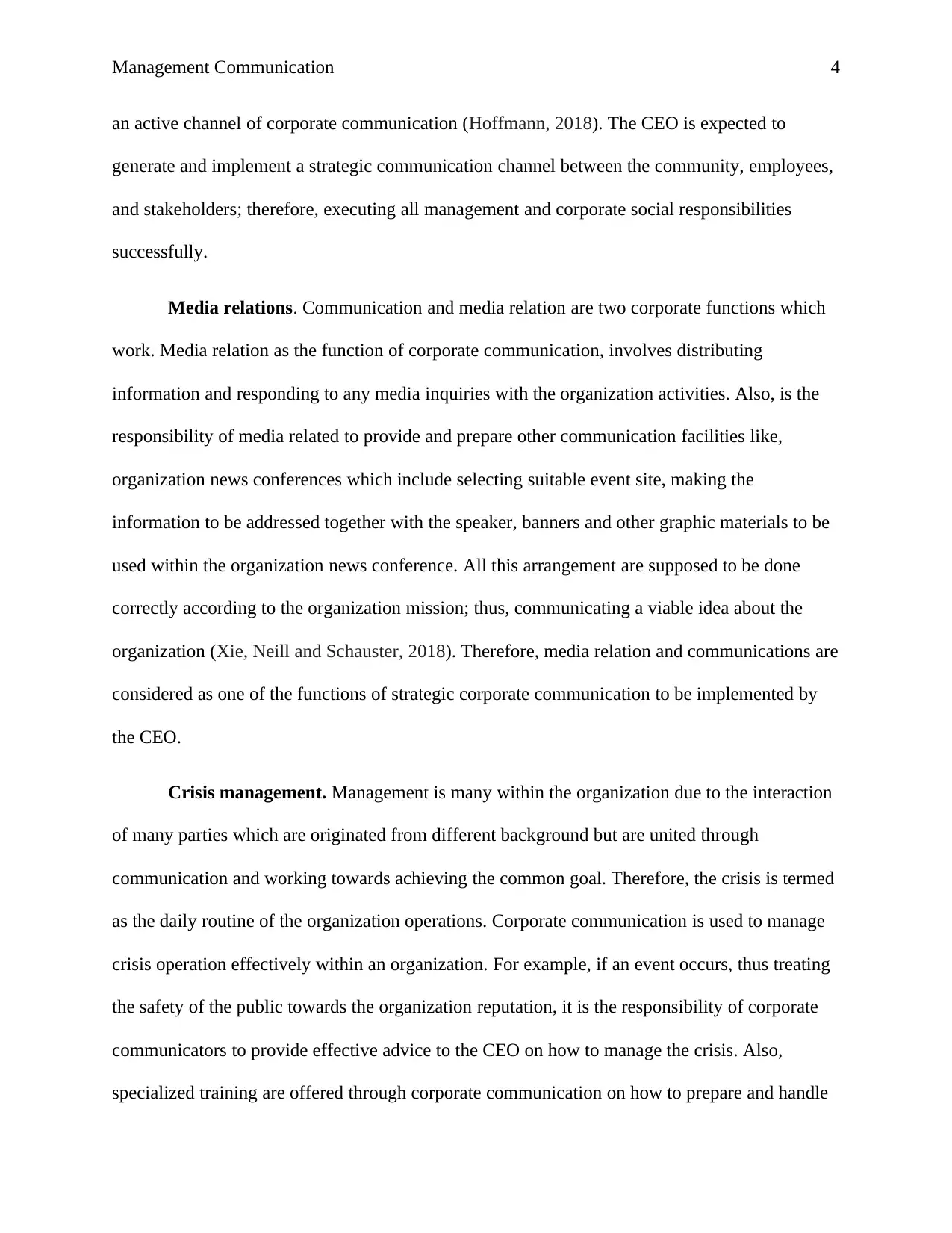
Management Communication 4
an active channel of corporate communication (Hoffmann, 2018). The CEO is expected to
generate and implement a strategic communication channel between the community, employees,
and stakeholders; therefore, executing all management and corporate social responsibilities
successfully.
Media relations. Communication and media relation are two corporate functions which
work. Media relation as the function of corporate communication, involves distributing
information and responding to any media inquiries with the organization activities. Also, is the
responsibility of media related to provide and prepare other communication facilities like,
organization news conferences which include selecting suitable event site, making the
information to be addressed together with the speaker, banners and other graphic materials to be
used within the organization news conference. All this arrangement are supposed to be done
correctly according to the organization mission; thus, communicating a viable idea about the
organization (Xie, Neill and Schauster, 2018). Therefore, media relation and communications are
considered as one of the functions of strategic corporate communication to be implemented by
the CEO.
Crisis management. Management is many within the organization due to the interaction
of many parties which are originated from different background but are united through
communication and working towards achieving the common goal. Therefore, the crisis is termed
as the daily routine of the organization operations. Corporate communication is used to manage
crisis operation effectively within an organization. For example, if an event occurs, thus treating
the safety of the public towards the organization reputation, it is the responsibility of corporate
communicators to provide effective advice to the CEO on how to manage the crisis. Also,
specialized training are offered through corporate communication on how to prepare and handle
an active channel of corporate communication (Hoffmann, 2018). The CEO is expected to
generate and implement a strategic communication channel between the community, employees,
and stakeholders; therefore, executing all management and corporate social responsibilities
successfully.
Media relations. Communication and media relation are two corporate functions which
work. Media relation as the function of corporate communication, involves distributing
information and responding to any media inquiries with the organization activities. Also, is the
responsibility of media related to provide and prepare other communication facilities like,
organization news conferences which include selecting suitable event site, making the
information to be addressed together with the speaker, banners and other graphic materials to be
used within the organization news conference. All this arrangement are supposed to be done
correctly according to the organization mission; thus, communicating a viable idea about the
organization (Xie, Neill and Schauster, 2018). Therefore, media relation and communications are
considered as one of the functions of strategic corporate communication to be implemented by
the CEO.
Crisis management. Management is many within the organization due to the interaction
of many parties which are originated from different background but are united through
communication and working towards achieving the common goal. Therefore, the crisis is termed
as the daily routine of the organization operations. Corporate communication is used to manage
crisis operation effectively within an organization. For example, if an event occurs, thus treating
the safety of the public towards the organization reputation, it is the responsibility of corporate
communicators to provide effective advice to the CEO on how to manage the crisis. Also,
specialized training are offered through corporate communication on how to prepare and handle
Paraphrase This Document
Need a fresh take? Get an instant paraphrase of this document with our AI Paraphraser
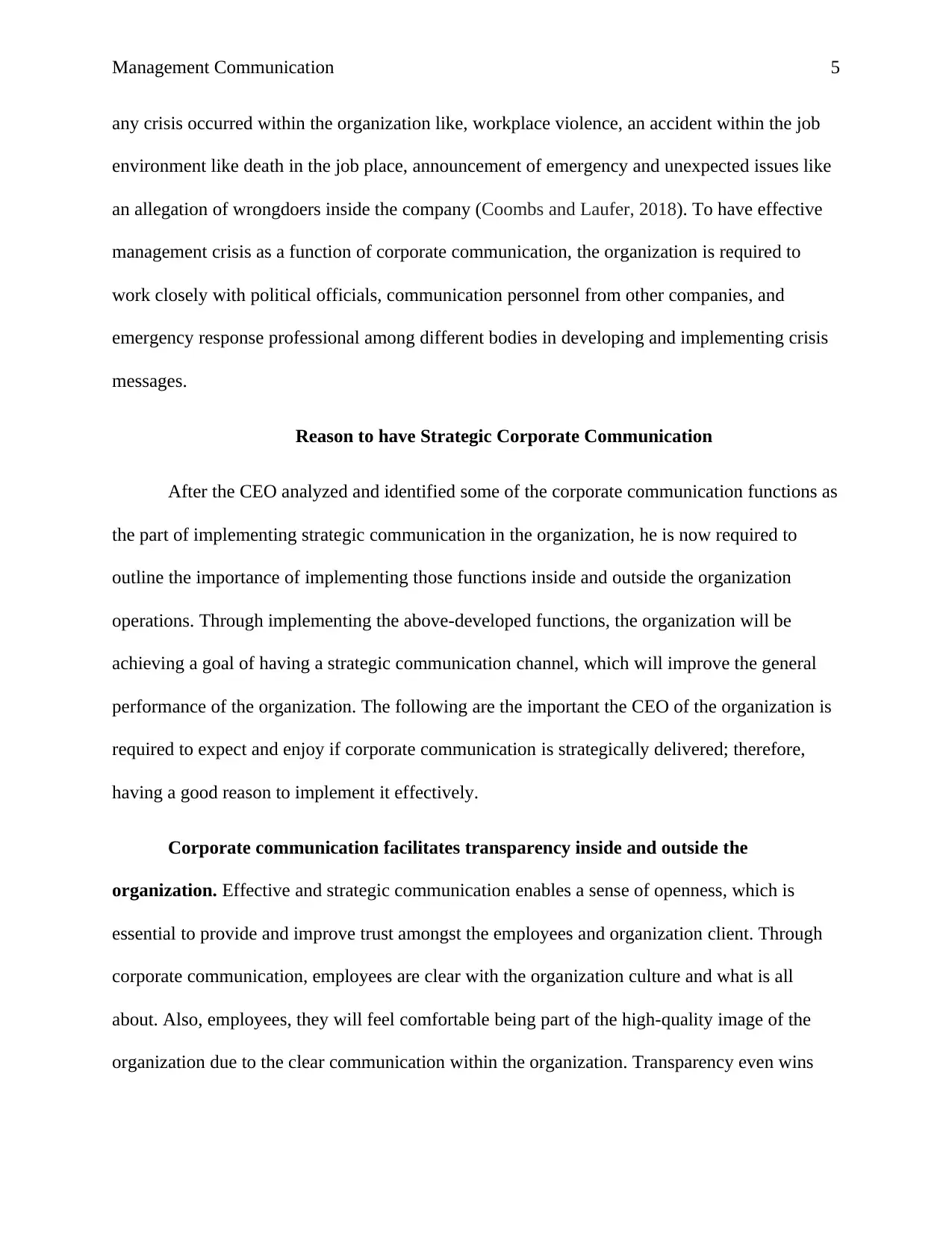
Management Communication 5
any crisis occurred within the organization like, workplace violence, an accident within the job
environment like death in the job place, announcement of emergency and unexpected issues like
an allegation of wrongdoers inside the company (Coombs and Laufer, 2018). To have effective
management crisis as a function of corporate communication, the organization is required to
work closely with political officials, communication personnel from other companies, and
emergency response professional among different bodies in developing and implementing crisis
messages.
Reason to have Strategic Corporate Communication
After the CEO analyzed and identified some of the corporate communication functions as
the part of implementing strategic communication in the organization, he is now required to
outline the importance of implementing those functions inside and outside the organization
operations. Through implementing the above-developed functions, the organization will be
achieving a goal of having a strategic communication channel, which will improve the general
performance of the organization. The following are the important the CEO of the organization is
required to expect and enjoy if corporate communication is strategically delivered; therefore,
having a good reason to implement it effectively.
Corporate communication facilitates transparency inside and outside the
organization. Effective and strategic communication enables a sense of openness, which is
essential to provide and improve trust amongst the employees and organization client. Through
corporate communication, employees are clear with the organization culture and what is all
about. Also, employees, they will feel comfortable being part of the high-quality image of the
organization due to the clear communication within the organization. Transparency even wins
any crisis occurred within the organization like, workplace violence, an accident within the job
environment like death in the job place, announcement of emergency and unexpected issues like
an allegation of wrongdoers inside the company (Coombs and Laufer, 2018). To have effective
management crisis as a function of corporate communication, the organization is required to
work closely with political officials, communication personnel from other companies, and
emergency response professional among different bodies in developing and implementing crisis
messages.
Reason to have Strategic Corporate Communication
After the CEO analyzed and identified some of the corporate communication functions as
the part of implementing strategic communication in the organization, he is now required to
outline the importance of implementing those functions inside and outside the organization
operations. Through implementing the above-developed functions, the organization will be
achieving a goal of having a strategic communication channel, which will improve the general
performance of the organization. The following are the important the CEO of the organization is
required to expect and enjoy if corporate communication is strategically delivered; therefore,
having a good reason to implement it effectively.
Corporate communication facilitates transparency inside and outside the
organization. Effective and strategic communication enables a sense of openness, which is
essential to provide and improve trust amongst the employees and organization client. Through
corporate communication, employees are clear with the organization culture and what is all
about. Also, employees, they will feel comfortable being part of the high-quality image of the
organization due to the clear communication within the organization. Transparency even wins
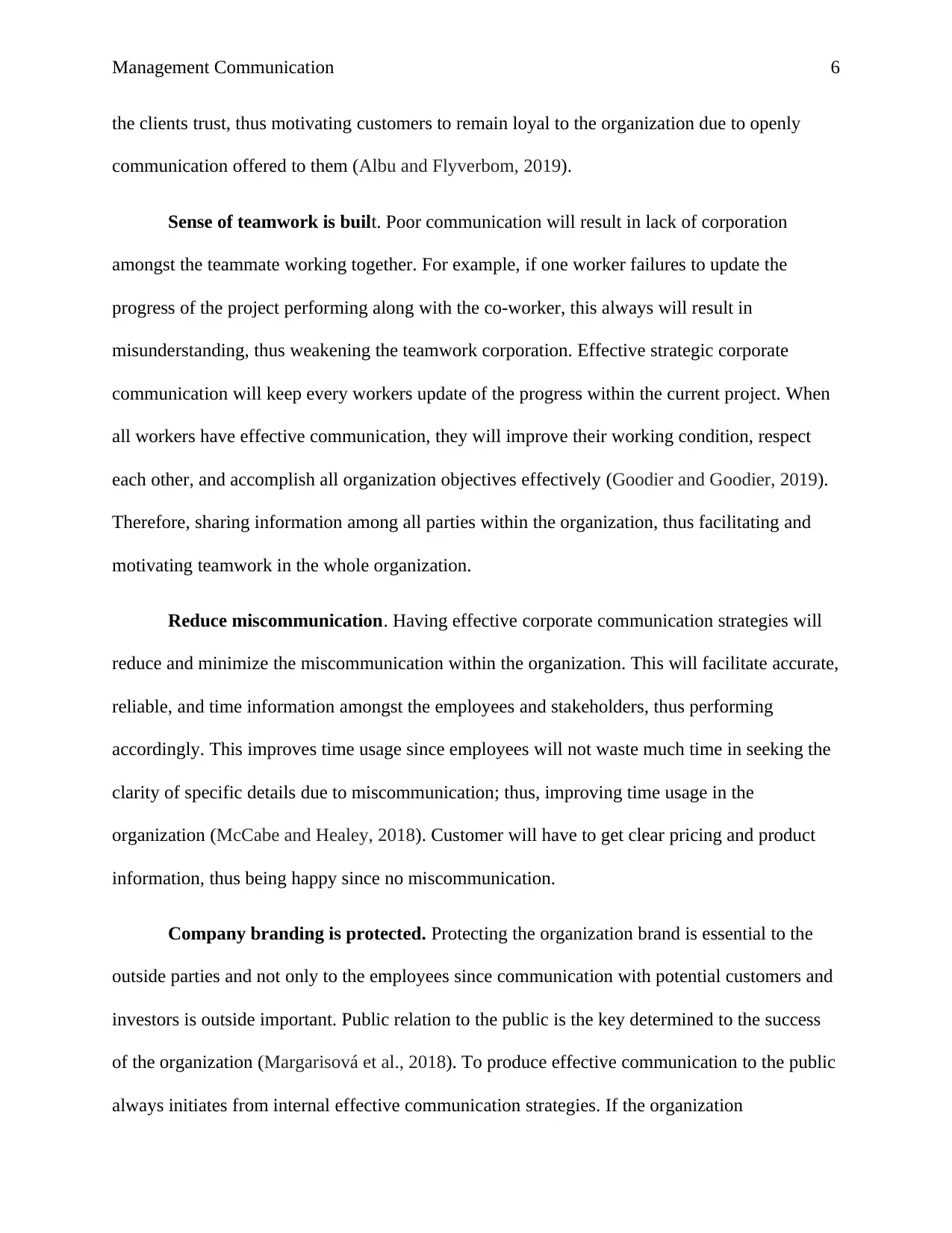
Management Communication 6
the clients trust, thus motivating customers to remain loyal to the organization due to openly
communication offered to them (Albu and Flyverbom, 2019).
Sense of teamwork is built. Poor communication will result in lack of corporation
amongst the teammate working together. For example, if one worker failures to update the
progress of the project performing along with the co-worker, this always will result in
misunderstanding, thus weakening the teamwork corporation. Effective strategic corporate
communication will keep every workers update of the progress within the current project. When
all workers have effective communication, they will improve their working condition, respect
each other, and accomplish all organization objectives effectively (Goodier and Goodier, 2019).
Therefore, sharing information among all parties within the organization, thus facilitating and
motivating teamwork in the whole organization.
Reduce miscommunication. Having effective corporate communication strategies will
reduce and minimize the miscommunication within the organization. This will facilitate accurate,
reliable, and time information amongst the employees and stakeholders, thus performing
accordingly. This improves time usage since employees will not waste much time in seeking the
clarity of specific details due to miscommunication; thus, improving time usage in the
organization (McCabe and Healey, 2018). Customer will have to get clear pricing and product
information, thus being happy since no miscommunication.
Company branding is protected. Protecting the organization brand is essential to the
outside parties and not only to the employees since communication with potential customers and
investors is outside important. Public relation to the public is the key determined to the success
of the organization (Margarisová et al., 2018). To produce effective communication to the public
always initiates from internal effective communication strategies. If the organization
the clients trust, thus motivating customers to remain loyal to the organization due to openly
communication offered to them (Albu and Flyverbom, 2019).
Sense of teamwork is built. Poor communication will result in lack of corporation
amongst the teammate working together. For example, if one worker failures to update the
progress of the project performing along with the co-worker, this always will result in
misunderstanding, thus weakening the teamwork corporation. Effective strategic corporate
communication will keep every workers update of the progress within the current project. When
all workers have effective communication, they will improve their working condition, respect
each other, and accomplish all organization objectives effectively (Goodier and Goodier, 2019).
Therefore, sharing information among all parties within the organization, thus facilitating and
motivating teamwork in the whole organization.
Reduce miscommunication. Having effective corporate communication strategies will
reduce and minimize the miscommunication within the organization. This will facilitate accurate,
reliable, and time information amongst the employees and stakeholders, thus performing
accordingly. This improves time usage since employees will not waste much time in seeking the
clarity of specific details due to miscommunication; thus, improving time usage in the
organization (McCabe and Healey, 2018). Customer will have to get clear pricing and product
information, thus being happy since no miscommunication.
Company branding is protected. Protecting the organization brand is essential to the
outside parties and not only to the employees since communication with potential customers and
investors is outside important. Public relation to the public is the key determined to the success
of the organization (Margarisová et al., 2018). To produce effective communication to the public
always initiates from internal effective communication strategies. If the organization
⊘ This is a preview!⊘
Do you want full access?
Subscribe today to unlock all pages.

Trusted by 1+ million students worldwide
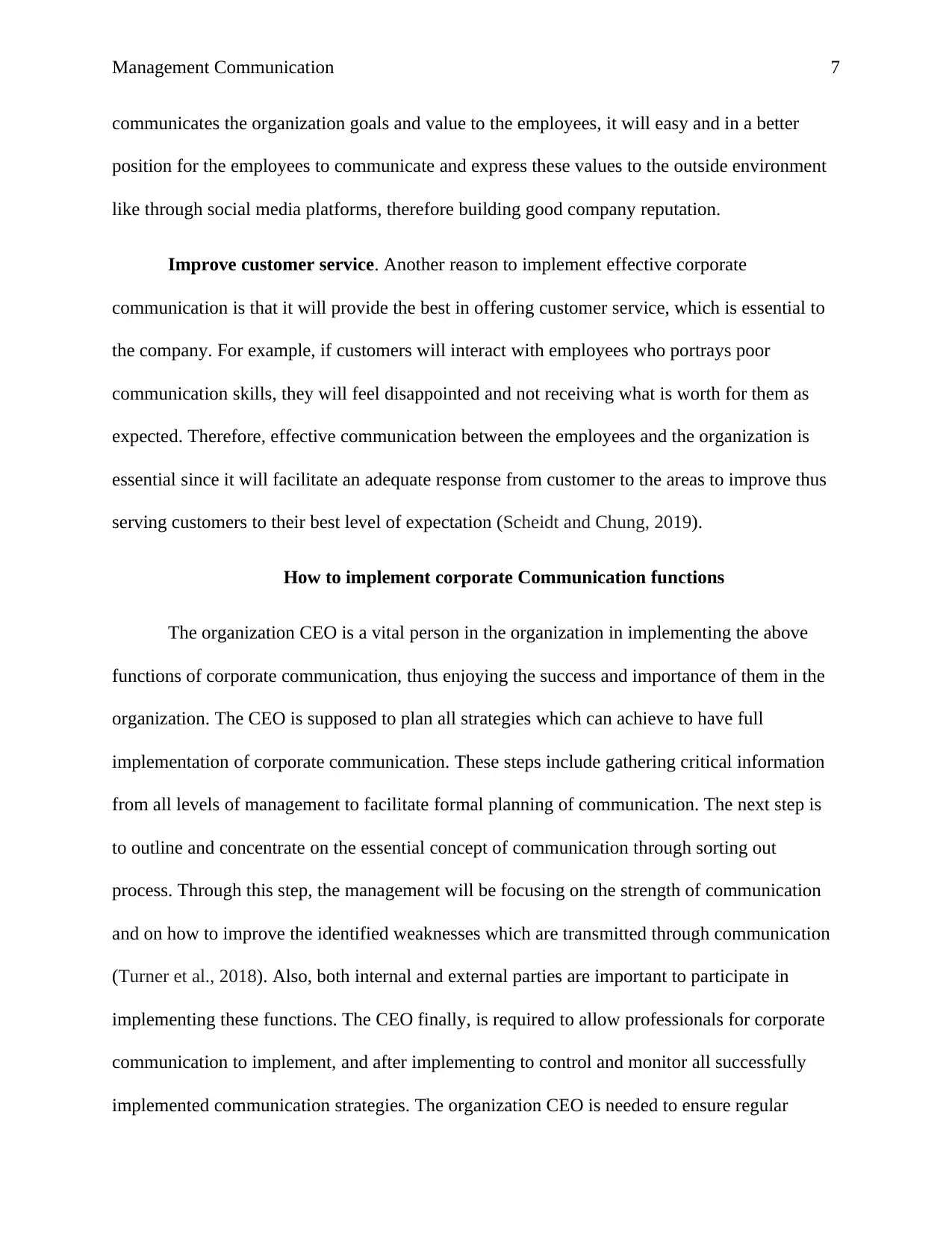
Management Communication 7
communicates the organization goals and value to the employees, it will easy and in a better
position for the employees to communicate and express these values to the outside environment
like through social media platforms, therefore building good company reputation.
Improve customer service. Another reason to implement effective corporate
communication is that it will provide the best in offering customer service, which is essential to
the company. For example, if customers will interact with employees who portrays poor
communication skills, they will feel disappointed and not receiving what is worth for them as
expected. Therefore, effective communication between the employees and the organization is
essential since it will facilitate an adequate response from customer to the areas to improve thus
serving customers to their best level of expectation (Scheidt and Chung, 2019).
How to implement corporate Communication functions
The organization CEO is a vital person in the organization in implementing the above
functions of corporate communication, thus enjoying the success and importance of them in the
organization. The CEO is supposed to plan all strategies which can achieve to have full
implementation of corporate communication. These steps include gathering critical information
from all levels of management to facilitate formal planning of communication. The next step is
to outline and concentrate on the essential concept of communication through sorting out
process. Through this step, the management will be focusing on the strength of communication
and on how to improve the identified weaknesses which are transmitted through communication
(Turner et al., 2018). Also, both internal and external parties are important to participate in
implementing these functions. The CEO finally, is required to allow professionals for corporate
communication to implement, and after implementing to control and monitor all successfully
implemented communication strategies. The organization CEO is needed to ensure regular
communicates the organization goals and value to the employees, it will easy and in a better
position for the employees to communicate and express these values to the outside environment
like through social media platforms, therefore building good company reputation.
Improve customer service. Another reason to implement effective corporate
communication is that it will provide the best in offering customer service, which is essential to
the company. For example, if customers will interact with employees who portrays poor
communication skills, they will feel disappointed and not receiving what is worth for them as
expected. Therefore, effective communication between the employees and the organization is
essential since it will facilitate an adequate response from customer to the areas to improve thus
serving customers to their best level of expectation (Scheidt and Chung, 2019).
How to implement corporate Communication functions
The organization CEO is a vital person in the organization in implementing the above
functions of corporate communication, thus enjoying the success and importance of them in the
organization. The CEO is supposed to plan all strategies which can achieve to have full
implementation of corporate communication. These steps include gathering critical information
from all levels of management to facilitate formal planning of communication. The next step is
to outline and concentrate on the essential concept of communication through sorting out
process. Through this step, the management will be focusing on the strength of communication
and on how to improve the identified weaknesses which are transmitted through communication
(Turner et al., 2018). Also, both internal and external parties are important to participate in
implementing these functions. The CEO finally, is required to allow professionals for corporate
communication to implement, and after implementing to control and monitor all successfully
implemented communication strategies. The organization CEO is needed to ensure regular
Paraphrase This Document
Need a fresh take? Get an instant paraphrase of this document with our AI Paraphraser
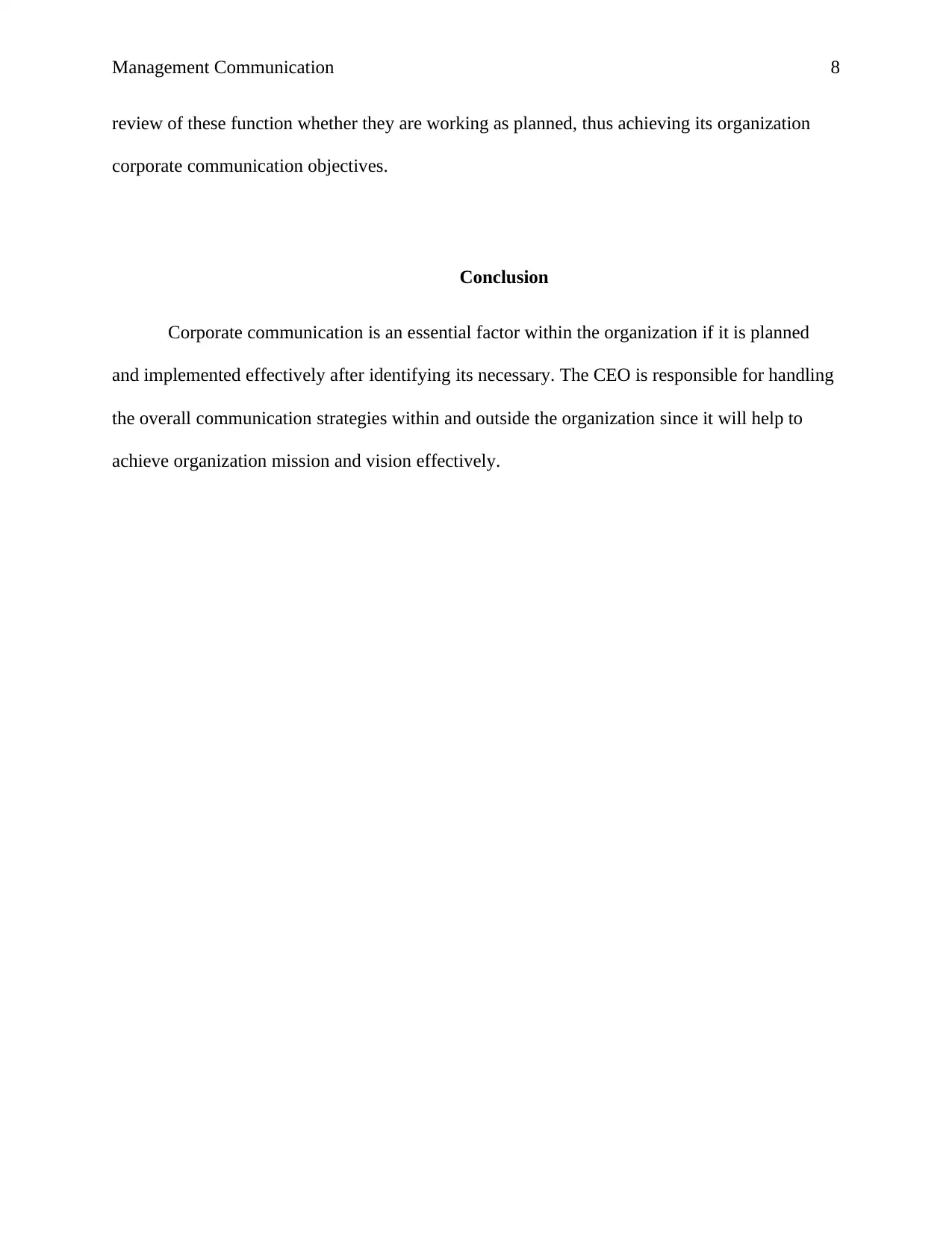
Management Communication 8
review of these function whether they are working as planned, thus achieving its organization
corporate communication objectives.
Conclusion
Corporate communication is an essential factor within the organization if it is planned
and implemented effectively after identifying its necessary. The CEO is responsible for handling
the overall communication strategies within and outside the organization since it will help to
achieve organization mission and vision effectively.
review of these function whether they are working as planned, thus achieving its organization
corporate communication objectives.
Conclusion
Corporate communication is an essential factor within the organization if it is planned
and implemented effectively after identifying its necessary. The CEO is responsible for handling
the overall communication strategies within and outside the organization since it will help to
achieve organization mission and vision effectively.
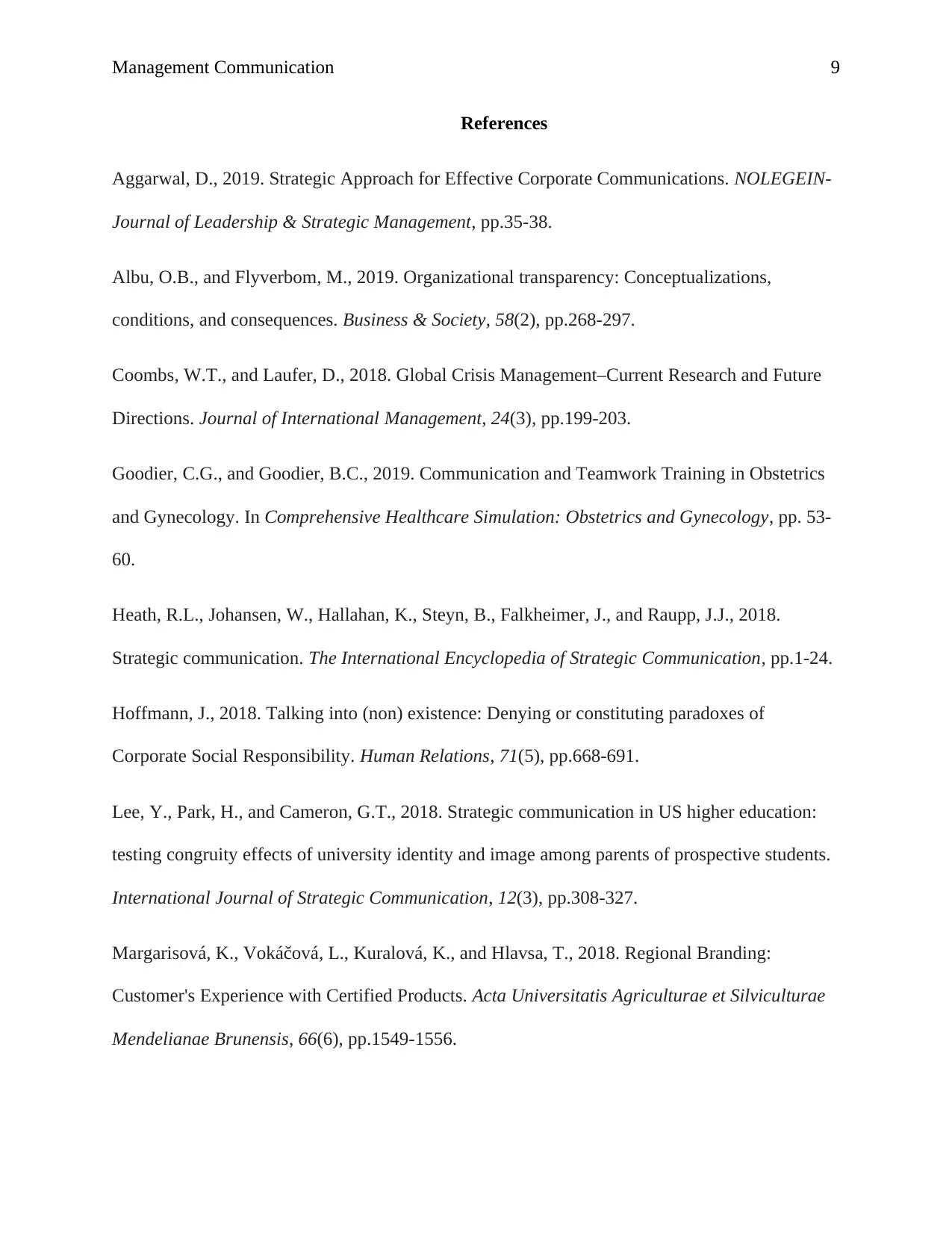
Management Communication 9
References
Aggarwal, D., 2019. Strategic Approach for Effective Corporate Communications. NOLEGEIN-
Journal of Leadership & Strategic Management, pp.35-38.
Albu, O.B., and Flyverbom, M., 2019. Organizational transparency: Conceptualizations,
conditions, and consequences. Business & Society, 58(2), pp.268-297.
Coombs, W.T., and Laufer, D., 2018. Global Crisis Management–Current Research and Future
Directions. Journal of International Management, 24(3), pp.199-203.
Goodier, C.G., and Goodier, B.C., 2019. Communication and Teamwork Training in Obstetrics
and Gynecology. In Comprehensive Healthcare Simulation: Obstetrics and Gynecology, pp. 53-
60.
Heath, R.L., Johansen, W., Hallahan, K., Steyn, B., Falkheimer, J., and Raupp, J.J., 2018.
Strategic communication. The International Encyclopedia of Strategic Communication, pp.1-24.
Hoffmann, J., 2018. Talking into (non) existence: Denying or constituting paradoxes of
Corporate Social Responsibility. Human Relations, 71(5), pp.668-691.
Lee, Y., Park, H., and Cameron, G.T., 2018. Strategic communication in US higher education:
testing congruity effects of university identity and image among parents of prospective students.
International Journal of Strategic Communication, 12(3), pp.308-327.
Margarisová, K., Vokáčová, L., Kuralová, K., and Hlavsa, T., 2018. Regional Branding:
Customer's Experience with Certified Products. Acta Universitatis Agriculturae et Silviculturae
Mendelianae Brunensis, 66(6), pp.1549-1556.
References
Aggarwal, D., 2019. Strategic Approach for Effective Corporate Communications. NOLEGEIN-
Journal of Leadership & Strategic Management, pp.35-38.
Albu, O.B., and Flyverbom, M., 2019. Organizational transparency: Conceptualizations,
conditions, and consequences. Business & Society, 58(2), pp.268-297.
Coombs, W.T., and Laufer, D., 2018. Global Crisis Management–Current Research and Future
Directions. Journal of International Management, 24(3), pp.199-203.
Goodier, C.G., and Goodier, B.C., 2019. Communication and Teamwork Training in Obstetrics
and Gynecology. In Comprehensive Healthcare Simulation: Obstetrics and Gynecology, pp. 53-
60.
Heath, R.L., Johansen, W., Hallahan, K., Steyn, B., Falkheimer, J., and Raupp, J.J., 2018.
Strategic communication. The International Encyclopedia of Strategic Communication, pp.1-24.
Hoffmann, J., 2018. Talking into (non) existence: Denying or constituting paradoxes of
Corporate Social Responsibility. Human Relations, 71(5), pp.668-691.
Lee, Y., Park, H., and Cameron, G.T., 2018. Strategic communication in US higher education:
testing congruity effects of university identity and image among parents of prospective students.
International Journal of Strategic Communication, 12(3), pp.308-327.
Margarisová, K., Vokáčová, L., Kuralová, K., and Hlavsa, T., 2018. Regional Branding:
Customer's Experience with Certified Products. Acta Universitatis Agriculturae et Silviculturae
Mendelianae Brunensis, 66(6), pp.1549-1556.
⊘ This is a preview!⊘
Do you want full access?
Subscribe today to unlock all pages.

Trusted by 1+ million students worldwide
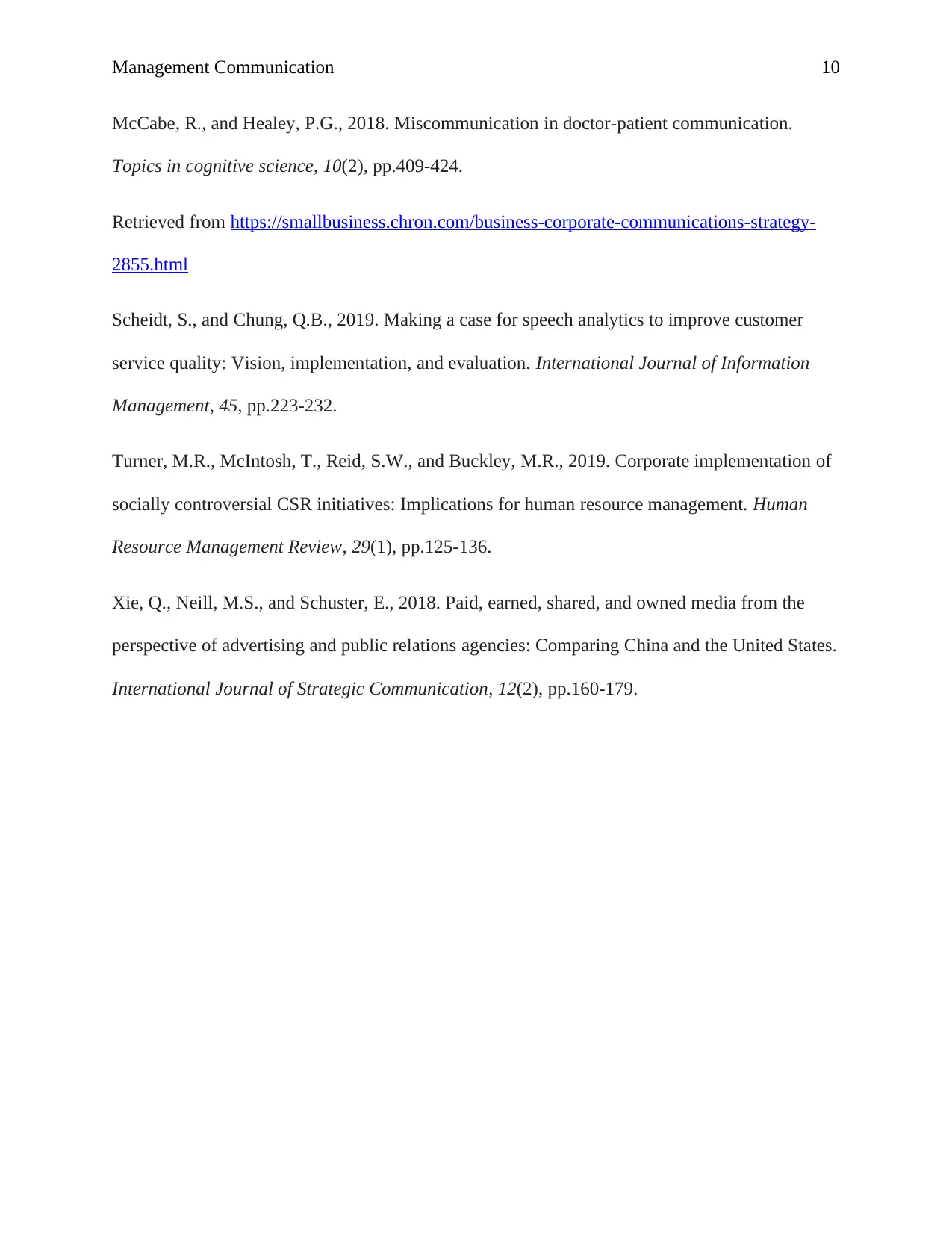
Management Communication 10
McCabe, R., and Healey, P.G., 2018. Miscommunication in doctor-patient communication.
Topics in cognitive science, 10(2), pp.409-424.
Retrieved from https://smallbusiness.chron.com/business-corporate-communications-strategy-
2855.html
Scheidt, S., and Chung, Q.B., 2019. Making a case for speech analytics to improve customer
service quality: Vision, implementation, and evaluation. International Journal of Information
Management, 45, pp.223-232.
Turner, M.R., McIntosh, T., Reid, S.W., and Buckley, M.R., 2019. Corporate implementation of
socially controversial CSR initiatives: Implications for human resource management. Human
Resource Management Review, 29(1), pp.125-136.
Xie, Q., Neill, M.S., and Schuster, E., 2018. Paid, earned, shared, and owned media from the
perspective of advertising and public relations agencies: Comparing China and the United States.
International Journal of Strategic Communication, 12(2), pp.160-179.
McCabe, R., and Healey, P.G., 2018. Miscommunication in doctor-patient communication.
Topics in cognitive science, 10(2), pp.409-424.
Retrieved from https://smallbusiness.chron.com/business-corporate-communications-strategy-
2855.html
Scheidt, S., and Chung, Q.B., 2019. Making a case for speech analytics to improve customer
service quality: Vision, implementation, and evaluation. International Journal of Information
Management, 45, pp.223-232.
Turner, M.R., McIntosh, T., Reid, S.W., and Buckley, M.R., 2019. Corporate implementation of
socially controversial CSR initiatives: Implications for human resource management. Human
Resource Management Review, 29(1), pp.125-136.
Xie, Q., Neill, M.S., and Schuster, E., 2018. Paid, earned, shared, and owned media from the
perspective of advertising and public relations agencies: Comparing China and the United States.
International Journal of Strategic Communication, 12(2), pp.160-179.
1 out of 10
Related Documents
Your All-in-One AI-Powered Toolkit for Academic Success.
+13062052269
info@desklib.com
Available 24*7 on WhatsApp / Email
![[object Object]](/_next/static/media/star-bottom.7253800d.svg)
Unlock your academic potential
Copyright © 2020–2025 A2Z Services. All Rights Reserved. Developed and managed by ZUCOL.





